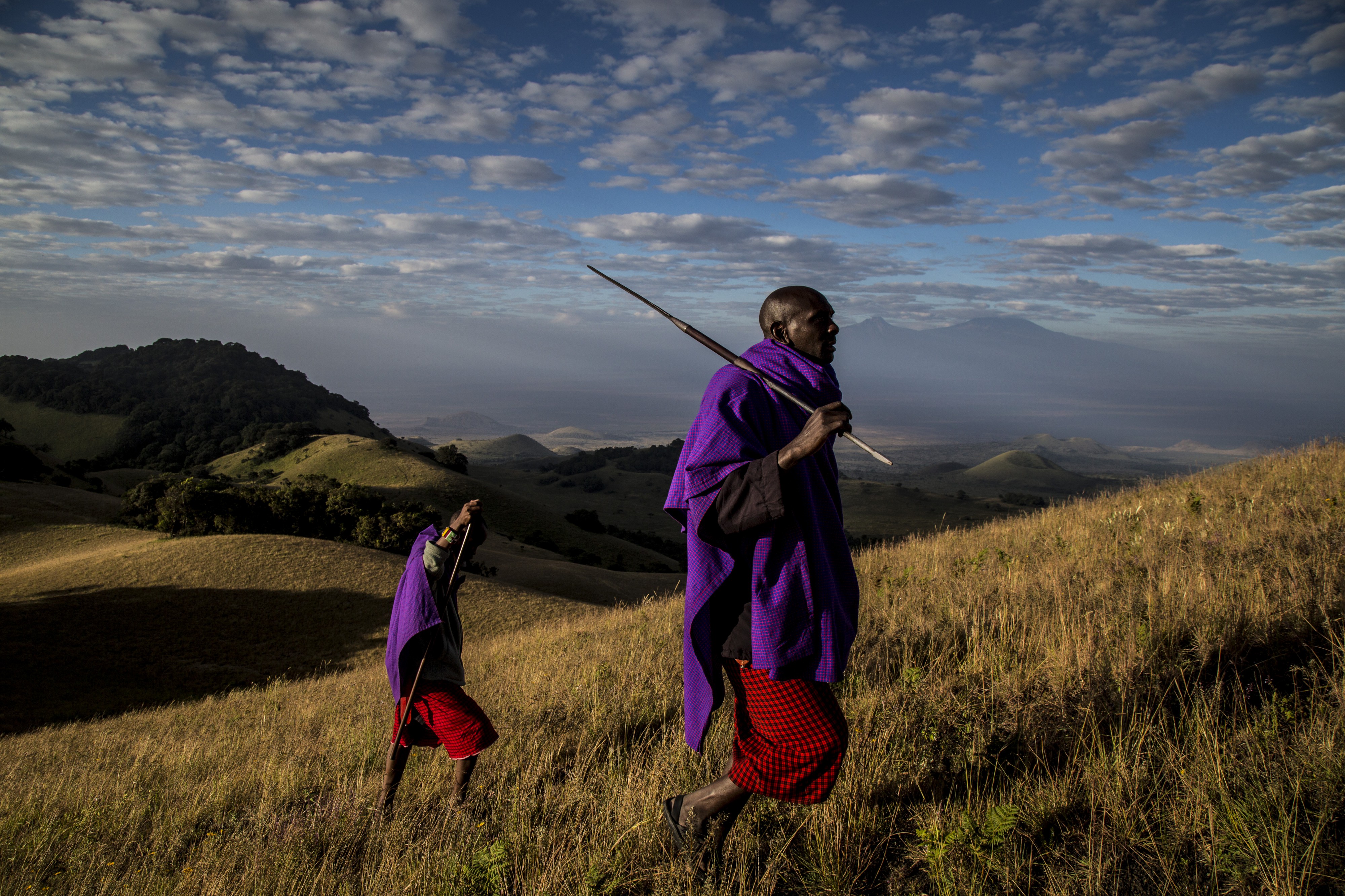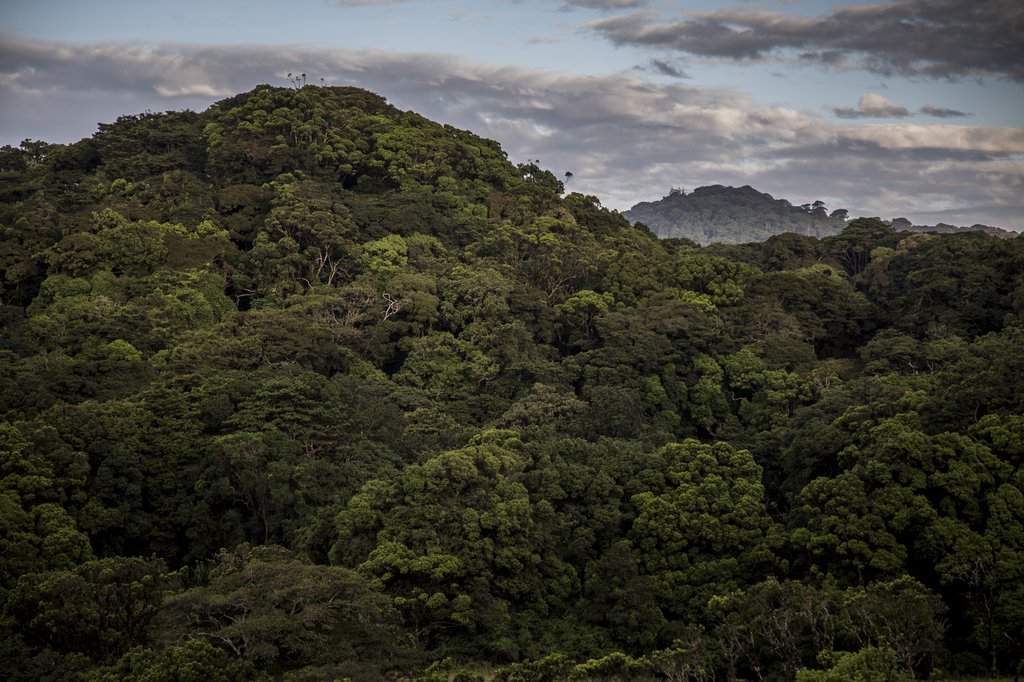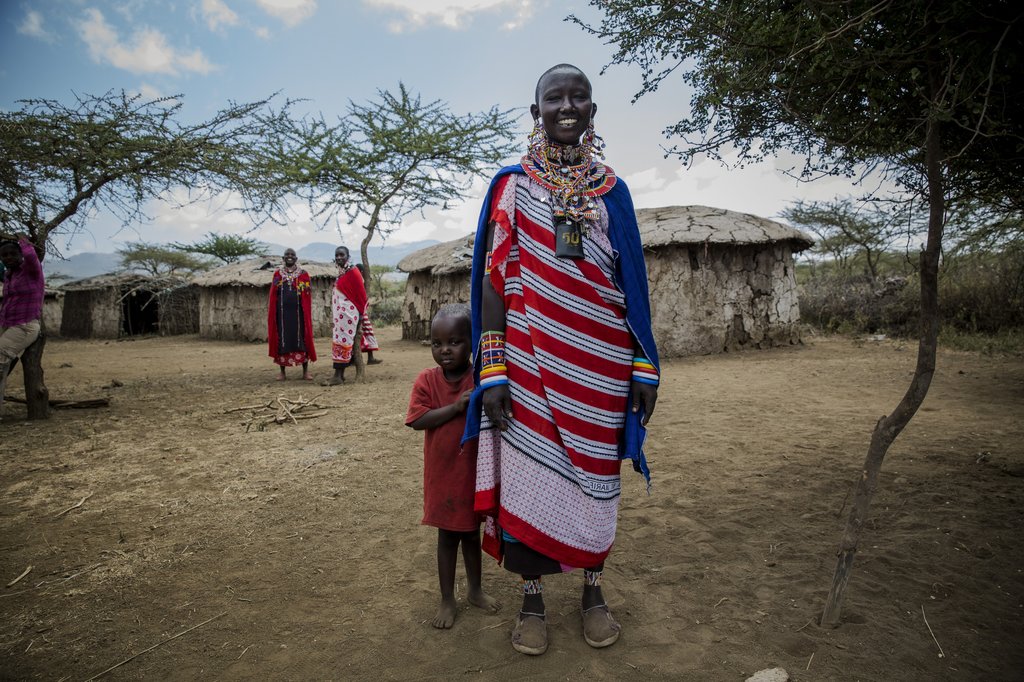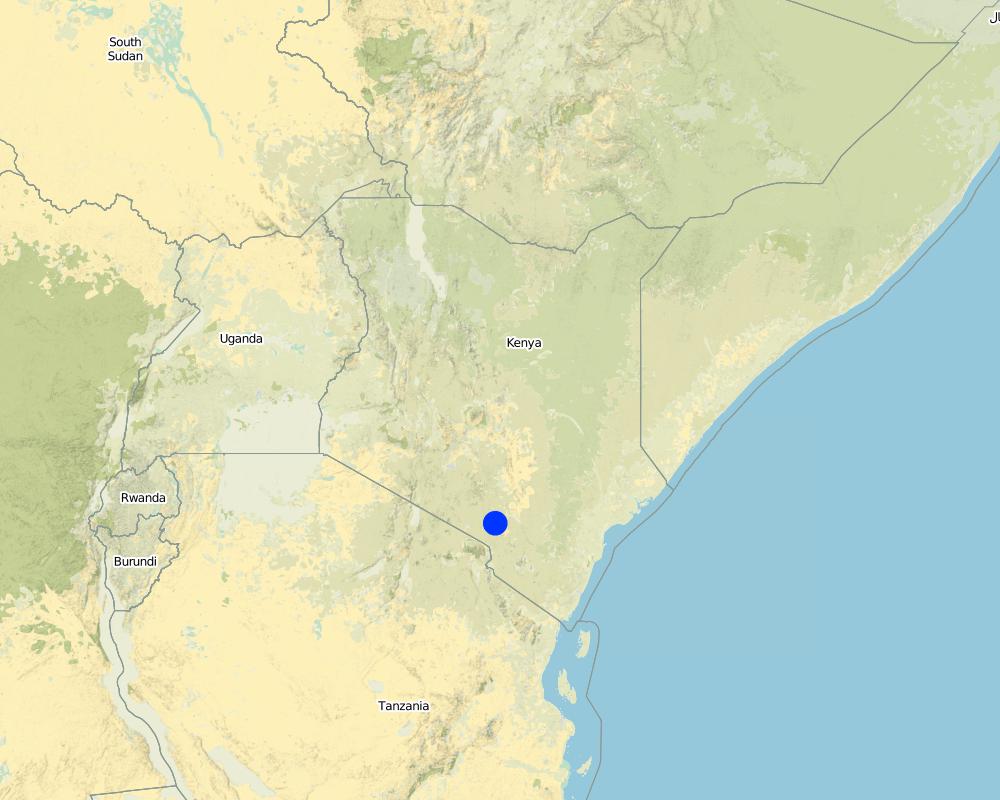Chyulu Hills Community REDD + Project [كينيا]
- تاريخ الإنشاء:
- تحديث:
- جامع المعلومات: Peter Tyrrell
- المحرر: Christina Ender
- المراجعون: Rima Mekdaschi Studer, Hanspeter Liniger, Donia Mühlematter
approaches_3426 - كينيا
عرض الأقسام
توسيع الكل طي الكل1. معلومات عامة
1.2 تفاصيل الاتصال بالأشخاص الرئيسيين لمصدر المعلومات والمؤسسات المعنية بتقييم وتوثيق النهج
اسم المشروع الذي سهّل توثيق/تقييم النهج (إذا كان ذلك على صلة)
Book project: Guidelines to Rangeland Management in Sub-Saharan Africa (Rangeland Management)1.3 الشروط المتعلقة باستخدام البيانات الموثقة من خلال WOCAT
متى تم تجميع البيانات (ميدانيا)؟:
28/02/201
يوافق جامع المعلومات والشخص (لاشخاص) الرئيسي لمصدر المعلومات على الشروط المتعلقة باستخدام البيانات الموثقة من خلال WOCAT:
نعم
1.4 المراجع الخاصة باستبيان(استبيانات) تقنيات الإدارة المستدامة للأراضي
2. وصف نهج الإدارة المستدامة للأراضي
2.1 وصف موجز للنهج
The Chyulu Hills REDD+ project combines two government agencies, three local NGOs and four communities together under a unified banner, the Chyulu Hills Conservation Trust (CHCT). The objective is to set-up a 30-year ‘payment for ecosystem service’ scheme in the landscape. A main goal of the project is to improve grazing and livestock management to prevent further degradation of the rangeland and forest resources.
2.2 وصف تفصيلي للنهج
وصف تفصيلي للنهج:
The Chyulu Hills, in southern Kenya, are a volcanic mountain range approximately 100 km long, and form a central pillar of the much larger Tsavo-Amboseli ecosystem which constitutes several national parks, forest reserves and community-owned pastoral land. The emission reduction project established in 2011 under the REDD+ umbrella (Reducing Emissions from Deforestation and forest Degradation) covers 410,000 hectares of both community and public land around the hills. REDD+ offers financial incentives to developing countries to manage and use their forests responsibly. Payments are channelled through the Trust to support land users for quantifiably reducing emissions.
REDD+ creates financial value for the carbon stored in forests by offering incentives for developing countries to reduce emissions from forested lands and invest in low-carbon paths to sustainable development. REDD+ goes beyond simply stopping further deforestation and forest degradation by including sustainable management and enhancement of forest carbon stocks.
This area is home to 140,000 people including Maasai pastoralists to the west, and Kamba farming communities to the east. This land is widely used for livestock production; must of it under communal tenure. Recent pressures, notably increasing populations and changes in land tenure, have led to unsustainable uses of natural resources, threatening the functioning of the ecosystem, through the degradation of the rangeland and over-exploitation of forest resources. This includes cutting of trees for firewood, charcoal, uncontrolled fires, and weakening of traditional grazing management systems.
The Chyulu Hills REDD+ project aims to protect its rangeland and forest landscapes by creating an alternative income opportunity, and improving both livestock and rangeland management, while preventing the emission of over 18 million tons of carbon dioxide over the project’s 30-year lifetime.
This is the first REDD+ project in Kenya that is fully owned and managed by the local community, a vital factor in ensuring sustained impact. Through the project, land users receive financial support per hectare for maintaining or improving carbon stocks above and below ground. Previous REDD+ projects have often been criticised for not properly engaging local communities or addressing their needs.
To achieve this, the Chyulu Hills Conservation Trust (CHCT) was formed in 2015 to act as the project governing body. The Trust represents multiple stakeholders from the community, government, and local NGOs including the Maasai Wilderness Conservation Trust (MMWCT), Big Life Foundation (BLF), and the David Sheldrick Wildlife Trust (DSWT). The government is also represented through the Kenya Wildlife Service (KWS) and Kenya Forest Service (KFS), whose mandates include the Chyulu Hills National Park and the Kibwezi Forest Reserve. The national park is used on an informal basis by the communities for dry season grazing, although access is severely limited by water, and also by disease.
The communities are represented by four Maasai group ranches, who manage the land and its resources. These group ranches are areas of communally titled land. The three NGOs have the technical capacity to advise, provide strategic guidance and assist in implementation of the project activities. They are already involved in helping communities to develop and manage conservation areas, and to improve sustainable use of natural resources.
Proceeds from the sale of Voluntary Emission Reductions (VERs) flow through the CHCT to initiatives/projects which benefit the community and environment. Early in 2017 the first verification was completed, and shortly afterwards the first marketable carbon credits went on sale, providing income to the CHCT for protecting and improving their carbon stock.
To ensure equitable and transparent sharing of proceeds from carbon sales, a revenue allocation model was implemented to fund (i) office and project costs, (ii) discretionary sub-projects, and (iii) to provide strategic investments to counter drivers of deforestation and land degradation.
The proposed investments into the CHCT area to improve rangeland condition comprise several components. The first component is to support grazing management plans to help restore governance over resources, and ensure sustainable use. This should encourage the recovery of perennial grasses, increase grass cover, and create a heterogeneous forage base. The second focus is value addition to beef marketing through collaborative partnerships. This should encourage pastoralists to focus on management of the rangelands to support the production of higher quality cattle. In the long run this will increase revenue generation for livestock farmers, and stimulate the communities to manage their rangeland better.
2.3 صور عن النهج
2.5 البلد/المنطقة/المواقع التي تم تطبيق النهج فيها
البلد:
كينيا
المنطقة/الولاية/المحافظة:
Kajiado and Makueni
مزيد من التفاصيل حول الموقع:
Chyulu Hills
Map
×2.6 تواريخ بدء وإنهاء تنفيذ النهج
أشر إلى سنة البدء:
2011
التعليقات:
The approach began in 2011, but the REDD+ project's form start date is September 2013. Please see the timeline figure.
2.7 نوع النهج
- قائم على مشروع/برنامج
2.8 الغايات/الأهداف الرئيسية للنهج
Provide carbon based funding to a local community trust to protect and improve the management of the Chyulu Hills and the surrounding ecosystem.
This project aims to:
- Deliver community benefits (such as health care, school bursaries, and income generating activities)
- Enhance forest protection (through protection, management and monitoring)
- Protect biodiveristy
- Restore degraded rangelands (improved livestock management and marketing)
- Enhance local governance
2.9 الظروف التي تمكن أو تعيق تنفيذ التقنية/التقنيات المطبقة بموجب النهج
المعايير والقيم الاجتماعية /الثقافية/ الدينية
- معيق
Consensus needs to be built between all community members who own and manage land under a communal title. This requires many meetings at various scales and with multiple stakeholders to ensure that consensus is reached, and that the resulting project is fair for all.
توفر/الوصول إلى الموارد والخدمات المالية
- تمكين/تمكيني
Financial resources were made available at the start by two international NGOs, namely the African Wildlife Foundation (AWF); and Conservation International (CI), which are not on the formal Board of CHCT. This allowed for the expensive process to be undertaken, including development of the Trust, and the process of carbon stock validation and sales.
- معيق
The sale of carbon credits is a limiting factor in revenue generation to run the project and implement activities.
الإطار المؤسساتي
- تمكين/تمكيني
Creation of the Chyulu Hills Conservation Trusts as a landscape institution ensures that all partners (community, government and NGO's) act for the good of the landscape, manage it collectively, and develop consensus on this approach.
التعاون/التنسيق بين الجهات الفاعلة
- تمكين/تمكيني
The Chyulu Hills Conservation Trust has a project office in the landscape and a Board of Trustees overseeing project implementation which greatly increases collaboration of actors with joint work plans.
الإطار القانوني (حيازة الأراضي، وحقوق استخدام الأراضي والمياه)
- معيق
Different parts of the landscape are managed by various authorities, such as National Park and Forest reserves by the government agencies, Kenya Wildlife Service and Kenya Forest Service respectively. The remaining area is under community land, which is titled as group ranches, a form of community land tenure in Kenya. The division between the two groups, the government and the community, can potentially cause conflict over access to forage, forest resources and water use.
المعرفة حول الإدارة المستدامة للأراضي، والوصول إلى الدعم الفني
- تمكين/تمكيني
The incorporation of a diverse set of NGOs into the project brings a range of SLM options and access to technical support.
3. المشاركة وأدوار الأطراف المعنية
3.1 أصحاب المصلحة المعنيون بالنهج وأدوارهم
- مستخدمو الأراضي المحليون/المجتمعات المحلية
Kuku Group Ranch
Kuku A Group Ranch
Mbirikani Group Ranch
Rombo Group Ranch
The communities are the owners of livestock and natural resources. They are nee in the formulation of strategies, in particular grazing management, in their areas.
- منظمة غير حكومية
Maasai Wilderness Conservation Trust
Big Life Foundation
David Sheldrick Wildlife Trust
These three NGO oversee the management of natural resources (each has agreements with the respective communities) and provide support for administration of the grants, technical and implementing expertise, and strategy development. They each operate in distinct geographical areas across both community and public land.
- الحكومة الوطنية (المخططون، صانعو القرار)
Kenya Wildlife Service
Kenya Forest Service
These two stakeholders are responsible for the management and project implementation within the officially gazetted protected areas. The Kenya Forest Service is instrumental in the national decision making and policy for the national REDD + programme.
- منظمة دولية
Conservation International
Functions as an advisory board member, providing strategic and technical guidance.
3.2 انخراط مستخدمي الأراضي المحليين/المجتمعات المحلية في المراحل المختلفة للنهج
| انخراط مستخدمي الأراضي المحليين/المجتمعات المحلية | حدد من شارك وصف الأنشطة | |
|---|---|---|
| المبادرة/التحفيز | تفاعلي | Initial conversations were motivated by two international NGOs (Conservation International and the African Wildlife Foundation). The project partners then held a large number of community meetings under the principle of free prior and informed consent (FPIC) to develop a unified platform to begin the process of investigating a mechanism in order to create an inclusive and fair REDD+ project (mainly lead by KWF). |
| التخطيط | تفاعلي | Planning of the project activities to be carried out under the REDD+ project was undertaken through a wide consultative process led by Conservation International, via community meetings and key information interviews. These are all captured in the Project Development Document (PDD) freely available online. |
| التنفيذ | تفاعلي | Implementation of the project was spearheaded by the project partners with technical and strategic guidance from Conservation International, including the validation, verification and initial sales of carbon credits. Local communities were closely involved in the development of the revenue allocation plan, the Trust structure, and development of the project activities and work plan. |
| الرصد/التقييم | تفاعلي | M&E is conducted by all involved NGOs and government agencies, and coordinated by one NGO currently holding the Project Office. Community members are integral to the collection and interpretation of data during this process. |
3.4 اتخاذ القرار بشأن اختيار تقنية/تقنيات الإدارة المستدامة للأراضي
حدد من الذي قرر اختيار التقنية/التقنيات التي سيتم تنفيذها:
- جميع الجهات الفاعلة ذات الصلة، كجزء من نهج تشاركي
اشرح:
Activities under this plan are implemented through both SLM experts and communities. The grazing management and livestock production activities originate from conversations between the communities, NGO partners and experts on rangeland management and livestock marketing and sale. These technologies are still in the early stages of development.
حدد على أي أساس تم اتخاذ القرارات:
- تقييم المعرفة الموثقة جيدًا بشأن الإدارة المستدامة للأراضي(اتخاذ القرارات القائمة على الأدلة)
- نتائج البحوث
- خبرة وآراء شخصية(غير موثقة)
4. الدعم الفني وبناء القدرات وإدارة المعرفة
4.1 بناء القدرات/التدريب
هل تم تقديم التدريب لمستخدمي الأراضي / الأطراف المعنيين الآخرين؟:
نعم
حدد من تم تدريبه:
- مستخدمو الأراضي
- موظفون ميدانيون/ مستشارون
إذا كان ذلك على صلة، حدد الجنس والعمر والوضع والعرق وما إلى ذلك.
A significant number of training has taken place so far. One example is training local women on grass seed bank management and farming, as well as building capacity of local scouts in wildlife data collection.
شكل التدريب:
- في العمل
- مناطق العرض
4.2 خدمة استشارية
هل يملك مستخدمو الأراضي وصولا إلى خدمة استشارية؟:
كلا
4.3 تعزيز المؤسسات (التطوير التنظيمي)
هل تم إنشاء أو تعزيز مؤسسات من خلال هذا النهج؟:
- نعم، إلى حد كبير
حدد المستوى (المستويات) التي تم فيها تعزيز أو إنشاء المؤسسات:
- محلي
- إقليمي
صف المؤسسة والأدوار والمسؤوليات والأعضاء وما إلى ذلك.
The Chyulu Hills Conservation Trust was established through this approach to bring together the two government agencies, the three local NGOs, and four community groups. The organisation is continually being strengthened with direct funding provided to the project office.
حدد نوع الدعم:
- مالي
- بناء القدرات/التدريب
- معدات
اعط مزيدا من التفاصيل:
One of the local NGOs has been appointed as in-charge of the Project Office, holding the responsibility for oversight and coordination across all partners, as well as management of the verification and audit events.
4.4 الرصد والتقييم
هل يشكل الرصد والتقييم جزءا من النهج؟:
نعم
التعليقات:
The REDD + carbon scheme documents forest, woody cover, and soil carbon, and is the main monitoring mechanism. Monitoring of rangeland condition, such as species composition, grass quality and quantity and ground cover is undertaken to evaluate the effect of changes in grazing management and livestock marketing.
إذا كانت الإجابة بنعم، فهل من المقصود استخدام هذه الوثائق للمراقبة والتقييم؟:
كلا
4.5 البحوث
هل كانت البحوث جزءًا من النهج؟:
نعم
حدد المواضيع:
- الاقتصاد / التسويق
- علم الايكولوجيا
أعط تفاصيل إضافية وأشر إلى من قام بالبحوث:
Research was conducted to establish the potential of the landscape for carbon sequestration for the REDD+ scheme.
5. التمويل والدعم المادي الخارجي
5.1 الميزانية السنوية لمكون الإدارة المستدامة للأراضي في النهج المذكور
إذا لم تكن الميزانية السنوية الدقيقة معروفة، قم بالإشارة إلى نطاقها:
- 1,000000-100،000
التعليقات (على سبيل المثال المصادر الرئيسية للتمويل/الجهات المانحة الرئيسية):
The initial implementation of the project cost more than 1 million USD over the course of six years. This was used to build community consensus, establish trust, measure carbon stocks within the areas and obtain validation and verification under two internationally acknowledged standards (the Verified Carbon Standard, and the Climate, Community and Biodiversity Standard.
5.2 الدعم المالي/المادي المقدم لمستخدمي الأراضي
هل حصل مستخدمو الأراضي على دعم مالي/ مادي لتنفيذ التقنية/ التقنيات؟:
نعم
إذا كانت الإجابة بنعم، حدد نوع (أنواع) الدعم والشروط والمزودين:
Implementation of the project was supported through funding by two international NGOs, and enhanced by project partners.
5.3 إعانات لمدخلات محددة (بما في ذلك العمالة)
- غير موجود
5.4 الائتمان
هل تم توفير ائتمان في إطار نهج أنشطة الإدارة المستدامة للأراضي؟:
كلا
5.5 حوافز أو وسائل أخرى
هل تم استخدام حوافز أو أدوات أخرى لتشجيع تنفيذ تقنيات الإدارة المستدامة للأراضي؟:
كلا
6. تحليل الأثر والتصريحات الختامية
6.1 آثار النهج
هل ساهم النهج في تمكين مستخدمي الأراضي المحليين وتحسين مشاركة الأطراف المعنية؟:
- لا
- نعم، قليلا
- نعم، باعتدال
- نعم، إلى حد كبير
The Approach ensures communities are the principle beneficiaries of funding received by the Trust; the technologies implemented are for improved rangeland management.
هل مكّن النهج من اتخاذ القرارات المبنية على الأدلة؟:
- لا
- نعم، قليلا
- نعم، باعتدال
- نعم، إلى حد كبير
The Approach monitors rangeland and forest resources, including vegetation, carbon stores and biodiversity, which can then be used by the Trust for evidence based decision making.
هل ساعد النهج مستخدمي الأراضي على تنفيذ وصيانة تقنيات الإدارة المستدامة للأراضي؟:
- لا
- نعم، قليلا
- نعم، باعتدال
- نعم، إلى حد كبير
The Approach provides technical and strategic expertise to communities to implement technologies at the spatial scale relevant to land management.
هل نجح النهج في تحسين التنسيق والتنفيذ الفعال من حيث التكلفة لأنشطة الإدارة المستدامة للأراضي؟:
- لا
- نعم، قليلا
- نعم، باعتدال
- نعم، إلى حد كبير
The Trust brings together community, government and NGO stakeholders in the landscape to improve coordination under joint work plans.
هل نجح النهج في تعبئة/تحسين الوصول إلى الموارد المالية لتنفيذ الإدارة المستدامة للأراضي؟:
- لا
- نعم، قليلا
- نعم، باعتدال
- نعم، إلى حد كبير
The Approach generates revenue through the sale of carbon credits, which is allocated to projects through the Trust and the revenue allocation model.
هل ساهم النهج في بناء/تعزيز المؤسسات والتعاون بين الأطراف المعنية؟:
- لا
- نعم، قليلا
- نعم، باعتدال
- نعم، إلى حد كبير
Through the creation of the Chyulu Hills Conservation Trust there is a new institution to build collaboration.
هل أدى النهج إلى توفير فرص عمل ودخل؟:
- لا
- نعم، قليلا
- نعم، باعتدال
- نعم، إلى حد كبير
Yes, this approach has provided more employment to the local communities, including transfer of new skills.
6.2 المحفز الرئيسي لقيام مستخدمي الأراضي بتنفيذ الإدارة المستدامة للأراضي
- زيادة الإنتاج
The condition of the rangeland within the area has deteriorated over recent years. There is a recognition among land-users that an approach is needed at the correct scale to restore and mange the rangelands.
- الحد من تدهور الأراضي
Land degredation is a wide-scale issues, and this approach supports communities to develop grazing managment plans and restoration.
6.3 استدامة أنشطة النهج
هل يمكن لمستخدمي الأراضي المحافظة على استدامة ما تم تنفيذه من خلال النهج (بدون دعم خارجي)؟:
- نعم
إذا كانت الإجابة بنعم، صف كيف:
The collaborative nature of the project, and the establishment of the Trust allows the community to sustain the approach due to the ongoing support of local NGOs and government. If the CHCT cannot sell Carbon Credits via the REDD+ scheme, then there will be severe limitations on the ability of the project to implement activities.
6.4 نقاط قوة/مزايا النهج
| نقاط القوة/ المزايا/ الفرص من وجهة نظر مستخدمي الأراضي |
|---|
| Communities are directly represented in the implementation of activities through representatives |
| There are clear potential financial benefits derived from the project through internal granting, community projects, and employment. |
| The approach will help improve the production of the rangeland and value of beef based products. |
| نقاط القوة/ المزايا/ الفرص من وجهة نظر جامع المعلومات أو غيره من الاشخاص الرئيسيين لمصدر المعلومات |
|---|
| Collaborative approach to Payments for Ecosystem Services (PES) which includes all the stakeholders required for successful implementation, including local representation, technical expertise, and national government agencies. |
| The approach tackles a range of drivers that have led to resource over exploitation and degradation, and has a clear plan and revenue allocation strategy to ensure an effective and equitable implementation of technologies to tackle these drivers. |
6.5 نقاط الضعف/ العيوب في المنهج وطرق التغلب عليها
| نقاط الضعف/ المساوىء/ المخاطر من وجهة نظر مستخدم الأراضي | كيف يمكن التغلب عليها؟ |
|---|---|
| Perceived imposition of grazing and rangeland management from NGOs, community leaders and the Trust Collaborative | Development of technologies to be implemented under this approach through the Group Ranch committees and local consultation with landowners. |
| نقاط الضعف/ المساوىء/ المخاطر من وجهة نظر جامع المعلومات أو غيره من الاشخاص الرئيسيين لمصدر المعلومات | كيف يمكن التغلب عليها؟ |
|---|---|
| Dependency on the REDD+ funding channels may lead to financial constraints if carbon credit sales do not happen. | Develop alternative financing mechanism beyond the sale of carbon credit. |
7. المراجع والروابط
7.1 طرق جمع/مصادر المعلومات
- مقابلات مع المتخصصين/الخبراء في الإدارة المستدامة للأراضي
Interview with key staff at CI
- التجميع من التقارير والوثائق الأخرى الموجودة
Reports, documents and fact sheets
الروابط والوحدات المواضيعية
توسيع الكل طي الكلالروابط
لا يوجد روابط
الوحدات المواضيعية
لا يوجد وحدات مواضيعية










